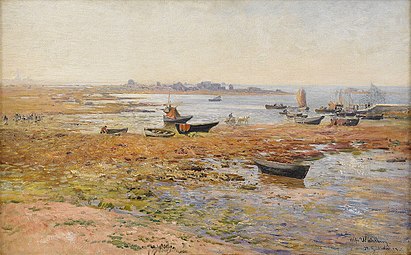Alfred Wahlberg


Herman Alfred Leonard Wahlberg[1] (13 February 1834 – 4 October 1906) was a Swedish landscape painter. [2]
Early life
Alfred Wahlberg was born in Stockholm, Sweden.
Career

Early career
Wahlberg enjoyed painting and decided to pursue his father's profession. He started by drawing landscapes, and sold a painting for the first time in 1856 to the Swedish Association of Art (Sveriges Allmänna Konstförening).[3]
In 1857, Wahlberg moved to the
He returned to Stockholm in 1862 and painted Svenskt insjölandskap från Kolmården (1866), which became very famous and was displayed at the National Museum of Arts. After his return to Stockholm in 1862, Wahlberg painted Storm på holländska kusten (1863), Fors i svensk obygd (largely influenced by Andreas Achenbach), Borgruinen Niedeck vid Rhen (1863), Skogsparti från Särö (1865), Hörningsholm i månsken (1866), and Svenskt insjölandskap från Kolmården (1866). The later is a carefully composed view of an infinite forest (Kolmården), a lake, and a summersky. The evening sky and the moonlight is depicted in mild, melting colors. The painting became very famous and was displayed at the National Museum of Arts. Although Wahlberg was still restricted by the limits of his technique, the painting was a large progress in his development as a painter.[3]
Later career
Wahlberg moved to
Wahlberg earned success and was awarded with medals at the Paris Salon in 1870 and 1872; these included the Order of Vasa.[7]
At the
Artistic Style
Wahlberg's fondness of romantic, dreaming, lyrical, and musical atmospheres is reflected in his paintings depicting the evening and the moonlight's play with tones and light.[3] Among his most famous paintings from this period are Fiskläge vid bohuslänska kusten (1869, bought by
Wahlberg's work from the late 1880s and forward includes Stockholms ström (1888), Månsken på Hallands Väderö (1889), Oktobernatt (1893), Popplar (1893), Sol på snö i Marstrand (1901), and Svensk sommarnatt (1901).
Gallery
-
Summer Day at the West Coast of Sweden
-
Summer landscape - motif from Ronneby
-
Moonlight mood, Stockholm's inlet
-
Fishing Boats at Saint Guénolé
References
- ^ Warburg, Karl (1881). "Herman Alfred Leonard Wahlberg". Från vår konstverld (in Swedish). Stockholm: Albert Bonniers Förlag. pp. 78–84.
- ^ "Herman Alfred Leonard Wahlberg". le peintres d’ecouen. 14 February 2017. Retrieved April 1, 2019.
- ^ a b c d e f g h i j k l Westrin, Th., ed. (1921). "Wahlberg, Herman Alfred Leonard". Nordisk familjebok (in Swedish). Vol. 31. Stockholm: Nordisk familjeboks förlags aktiebolag. pp. 322–324. Retrieved 1 January 2010.
- ^ a b c d Nordensvan, Georg (1928). "Karl XV:s tid. De gamla och de unga". Svensk konst och svenska konstnärer i nittonde århundradet (in Swedish). Vol. II. Stockholm: Albert Bonniers Förlag. pp. 125–126.
- ^ "Alfred Wahlberg". Svea folkkalender. Retrieved April 1, 2019.
- ^ "Alfred Wahlberg". Bukowskis. Retrieved April 1, 2019.
- Gallica
![]() This article contains content from the Owl Edition of Nordisk familjebok, a Swedish encyclopedia published between 1904 and 1926, now in the public domain.
This article contains content from the Owl Edition of Nordisk familjebok, a Swedish encyclopedia published between 1904 and 1926, now in the public domain.
External links
- . New International Encyclopedia. 1905.
- More works by Wahlberg @ ArtNet




